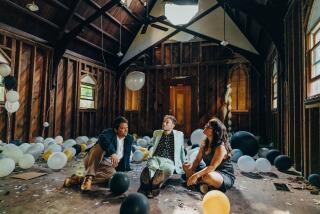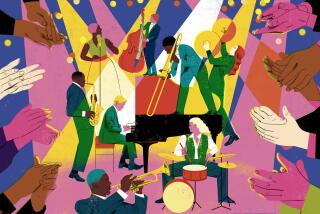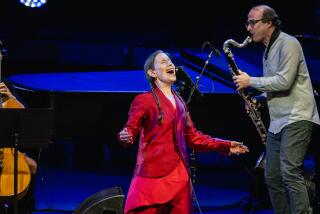Proudly lacking direction
When the Necks take the stage at REDCAT on Thursday night, there will surely be some confused looks darting around the audience before the performance begins. If the Australian piano trio’s pattern holds -- as it has for the last 22 years -- the musicians will stand over their instruments, heads bowed, waiting for complete silence to fill the room. No one moves, no one makes a sound, until inspiration strikes.
Dedicated to in-the-moment musicianship and slowly evolving group improvisations that usually swell to an hour in length, the Necks are not your typical jazz trio. Coming together out of the Sydney jazz scene in the mid-1980s, each member of the Necks felt pulled to other styles of music and music creation that didn’t mesh with the experience of performing straight jazz.
“I think we all just felt that a lot of contemporary jazz labors under a bit of an information overload,” said Lloyd Swanton, who in addition to playing bass for the Necks still performs in a number of jazz ensembles around Sydney. “There’s just too much going on, and we wanted to bring things down to a much finer focus, to look at just the really basic building blocks of music and see if there was still inspiration to be gained from that.”
Though most of the Necks’ albums adhere to the single, drawn-out song aesthetic established by their performances and touch on elements of Steve Reich-ian minimalism, African trance and the instrumental post-rock of Tortoise and Pell Mell, their sound still often operates under the furthest reaches of jazz’s long shadow.
The group has gained some recognition for its unusual approach, taking home a number of honors from Australia’s equivalent to the Grammys, the Australian Record Industry Assn. Awards.
Although members of the Necks also referenced Mal Waldron and John Coltrane in discussing influences from the world of jazz, it’s the simmering rhythmic tension of Miles Davis’ “In a Silent Way” that feels like the obvious touchstone.
“That was a very influential album when we were forming the band. . . . To put it in really simplistic terms, we looked at what the rhythm section was doing and said, ‘What if that’s all you did?’ ” Swanton said. “What if there wasn’t a person soloing over the top, that the entire product was that? It’s sort of the sound of three people not soloing all at once.”
Though the Necks’ studio recordings vary in style and instrumentation, the live shows are rigidly defined. Only acoustic instruments are used, and living in the now is sacrosanct.
But whereas many free improvisation groups begin with each player flying out of the blocks full-throttle, the Necks wait for just one of them to set the performance in motion. Like an up-close magic act, no instructions are shared beforehand, no backstage deals are brokered. Just a pure ebbing and flowing exercise in action and reaction.
“I think we discovered a new way of playing and a new way of experiencing music that I’d never had before. Just the ability to play something and really listen to what you’re playing and allowing things to develop in their own time,” said keyboardist Chris Abrahams. “It’s sort of like being a part of the audience and being a musician at the same time.”
But with music centered on slowly evolving patterns that spiral into something more, it’s the Necks’ audience that may also undergo a transformation.
“The communal listening experience in being in the audience for the Necks is so different . . . because they do actually cast a spell,” said John Shand, jazz critic for the Sydney Morning Herald and author of “Jazz: The Australian Accent.” “Because you can be listening to something that’s more or less unchanging for six or seven minutes and then quite a minor change might occur and that might breed another minor change from one of the others.
“If you lose concentration for a minute or two at a crucial part of one of the improvisations, you can snap back into listening to the music and realize they’re all playing completely different parts and you have no idea how they got there.”
The band might have earned its biggest following in experimental rock circles having recently played the Big Ears Festival in Knoxville, Tenn., with fellow fringe-dwellers Fennesz and Philip Glass, but for the most part, those who followed the Necks into the unknown have been grateful for the journey, regardless of where they’re coming from.
“The feedback we get from the audience time and time again is, ‘I can’t believe that was an hour, that felt like three minutes,’ ” Swanton said.
“I think in an era where everything is getting compressed down to sound bites, we find it liberating and refreshing -- and I believe the audience does too -- to say, ‘Stop everything, drop what you’re doing and let’s just sit here for an hour and enjoy that hour.’ ”
--
--
The Necks
Where: REDCAT at Walt Disney Concert Hall, 631 W. 2nd St., Los Angeles
When: 8:30 p.m. Thursday
Price: $35, $28 for students, $18 for CalArts students and faculty
Contact: (213) 237-2800, www.redcat.org
More to Read
The biggest entertainment stories
Get our big stories about Hollywood, film, television, music, arts, culture and more right in your inbox as soon as they publish.
You may occasionally receive promotional content from the Los Angeles Times.










